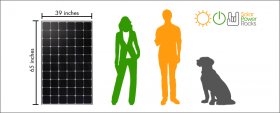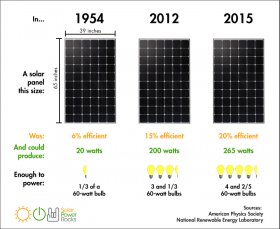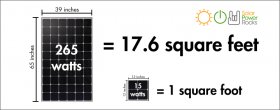
Electricity Generated by solar Panels
 By Ben Zientara
By Ben Zientara
The amount of electricity a solar panel produces depends on three main things: the size of the panel, the efficiency of the solar cells inside, and the amount of sunlight the panel gets.
We’ll break down what you can expect from a typical solar panel, and how that power output compares to the power you need for the gadgets and appliances you use inside your home.
How big are solar panels?
When we say “solar panel, ” what we’re talking about is a typical silicon photovoltaic panel. These days, most solar panels are about 5 and a half feet tall and a little more than 3 feet wide:
If you look closely at the solar panel in the image above, you’ll notice 60 little squares. These squares are actually individual solar “cells, ” which are linked together by wires. The cells are where electricity is made, and the wires carry the electricity to a junction box where the panel is hooked into a larger array.
Why does solar panel size matter?
The more solar cells working in tandem, the more power they’ll create. That’s why the size of the panel matters if you’re trying to calculate how much electricity a panel makes.
Solar panels have been about this size for decades, but modern panels make more electricity than in the past. That’s because panel manufacturers have found ways to improve cell efficiency over time.
 How efficient are solar panels?
How efficient are solar panels?
Solar efficiency relates to the amount of available energy from the sun that gets converted into electricity.
Back in the 1950s, the first solar cells were capable of taking 6% of the energy from the sun and converting it into electricity.
If they were configured to be the same array of 60 cells you see in the image above, that would have created a current of about 20 watts electricity, about a third of what would be needed to light up a 60 watt incandescent bulb.
When we originally wrote this page in 2012, solar cells could convert 15% of the energy hitting them from the sun into power. As of 2017, solar cell efficiency is closer to 20%.
If you combine the efficiency of the cells with the size of the panel, you get a number called the “power rating.” In the solar industry, we say “that panel is rated to produce X watts.”
What’s the power rating for an average solar panel?
As of 2017, a typical solar panel produces around 265 watts of power. That can vary based the size and efficiency of the solar panel you choose; you’ll see panels that produce 210, 280, even 320 watts.
 More efficient panels are a little more expensive, and are usually only needed if you have limited space on your roof.
More efficient panels are a little more expensive, and are usually only needed if you have limited space on your roof.
It generally matters less how much each panel can produce than how well the whole array performs.
How is a solar panel’s rating calculated?
Your solar panels will have a number listed on the back that indicates how much power they will pump out during ideal conditions. This is called the Standard Test Condition rating (STC for short).
Here’s what a label looks like on the back of the solar panel:
To determine an STC rating, solar labs test the panels under ideal conditions called “peak sun, ” or 1000 watts of sunlight per square meter of surface. That’s approximately equal to the power of the sun at noon, on a sunny day, at the equator.
In the picture above, the label shows an STC rating of 250 watts for the panel. If that panel received full sun for one hour, you’d get 250 watt-hours of electricity. With 4 panels, you’d get a kilowatt hour. Click here to read more about the difference between a kilowatt and a kilowatt hour.
Solar panel output calculator (kWh)
Even if you live at or near the equator, you can’t expect to replicate these ideal conditions. The amount of electricity solar panels produce depends on average sunlight over the course of a year. If it’s historically more cloudy in your area, there’s less available energy from the sun to convert into electricity.
The first step to figuring out how much electricity your solar panel can produce in a year is to find your place on the globe. If you live in the United States, you can figure out how to calculate the amount of electricity a solar panel produces and how much you can save using our simple solar calculator:
If you live outside the United States, check out Weather Underground’s solar calculator. You can enter your address into it and get specific details about how much sunlight hits your house on average. The calculator also gives the option of entering a specific model of solar panel and the square footage of the panel coverage on your roof.











